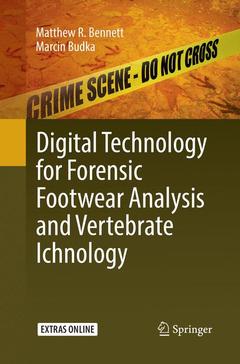Digital Technology for Forensic Footwear Analysis and Vertebrate Ichnology, 1st ed. 2019
Auteurs : Bennett Matthew R., Budka Marcin

?There is no branch of detective science which is so important and so much neglected as the art of tracing footsteps. Happily, I have always laid great stress upon it, and much practice has made it second nature to me.? Sherlock Holmes, Study of Scarlet.
Despite the fictional nature of Sherlock Holmes this statement rings true today. The study of footwear is neglected in modern forensic practice and does have much to offer. What it needs is an injection of technology and modern analytical tools. These tools are emerging from the digital revolution currently transforming vertebrate ichnology. Ichnology is the discipline of earth science which focuses on the study of trace fossils such as footprints. This book draws upon both disciplines - geology (ichnology) and forensic science - to show how the two have much to learn from each other especially with regard to the digital capture and analysis of footprints.
This book presents field and laboratory methods associated with the collection, analysis and presentation of three-dimensional tracks (footprints) whether from a crime scene or a geological/archaeological excavation. It shows students, researchers and practitioners how to collect and analyse 3D data and take advantage of the digital revolution transforming ichnology.
This book is not only essential reading for forensic and earth science students but also for professional forensic practitioners as well as for applied computer scientists developing new tools for visualization and analysis of 3D data. The book forms a natural methods focused complement to the successful text Fossilised Locomotion published by Springer 2014.
Professor Matthew Bennett's passion for geography and geology comes from a childhood spent in Snowdonia. Born in Oldham (UK) Matthew has worked widely throughout the world on a range of geological projects. He completed his BSc in Physical Geography at Queen Mary College (University of London) in 1988 and went on to do a PhD in glacial geology in 1991 at Edinburgh University. Taking up an appointment at the University of Greenwich in 1992 Matthew worked throughout the 1990s on a range of glacial and Quaternary research projects in the Arctic specifically in Norway, Svalbard, Iceland, Alaska and Canada, as well as throughout the UK. He published widely on aspects of glaciology, sedimentology and geomorphology. In 2002 he joined Bournemouth University as Professor in Environmental and Geographical Sciences and started to work in Central America on various Quaternary and geo-archaeological projects. In 2007 he was invited to join the Koobi Fora Field School organised at the time by Rutgers University and the National Museum of Kenya. His work on the Ileret footprints was published in Science in 2009. This human track site is the second oldest known human footprint site in the world and dates from 1.5 million years ago. Since then, and working extensively throughout Africa, Matthew has published widely on ancient footprints developing new techniques and analytical procedures. In 2015, in conjunction with Professor Marcin Budka, Matthew was awarded an Innovation Grant by Natural Environment Research Council (NERC) to translate their footprint research in to a practical tool for use by forensic scientists. This project was supported by the UK Home Office and National Crime Agency. The result was the launch of DigTrace (Digital Tracks Capture and Analysis) an integrated freeware solution for the capture and analysis of footwear (& footprint) evidence in July 2016.
Professor Marcin Budka receiv
Presents a fusion of forensics, geology, and computer science for students, researchers, and practitioners
Covers field methods and protocols for 3D data collection both in the context of vertebrate paleontology and forensic crime scenes
Reviews analytical and computational techniques including presentation and visualization for the study of 3D data and associated point clouds
Examines analytical techniques for the study of footprint traces from simple linear metrics through to whole foot analyses
Offers detailed case studies with a practical focus and worked examples
Date de parution : 12-2018
Ouvrage de 251 p.
15.5x23.5 cm
Disponible chez l'éditeur (délai d'approvisionnement : 15 jours).
Prix indicatif 58,01 €
Ajouter au panierDate de parution : 09-2018
Ouvrage de 251 p.
15.5x23.5 cm
Disponible chez l'éditeur (délai d'approvisionnement : 15 jours).
Prix indicatif 58,01 €
Ajouter au panier


